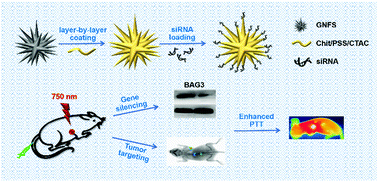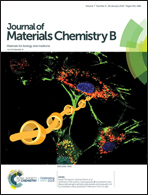Flower-like gold nanoparticles for enhanced photothermal anticancer therapy by the delivery of pooled siRNA to inhibit heat shock stress response†
Abstract
Due to the anti-apoptotic effect employed by cells to protect themselves, recent research shows that photothermal therapy (PTT) can lead to heat shock response, thus reducing the effect of treatment on cancer cells. Small interfering RNA (siRNA), as an effective carrier of RNA interference, can silence the expression of heat shock protein, HSPs or BAG3 genes by inhibiting the expression of specific genes, and thereby inhibiting heat shock response and making cancer cells more sensitive to PTT. In this study, flower-like gold nanoparticles were used as a core for a layer-by-layer strategy to produce a safe and biodegradable nanoparticle platform for gene silencing and photothermal therapy. The results showed that when the mass ratio of the GNFs and siRNA was 20 : 1, the loading efficiency was above 90%, which can effectively silence the expression of BAG3 siRNA. We demonstrated that the GNFs–siRNA still had a good photothermal effect after siRNA modification. In vitro, the GNFs–siRNA showed good biocompatibility and effectively tumor killing properties after laser irradiation. Furthermore, the GNFs–siRNA with laser treatment significantly decreased the expression of BAG3 and remarkably inhibited tumor growth in vivo. This nanosystem establishes an optimized platform for future gene delivery and photothermal therapy.

- This article is part of the themed collection: International Year of the Periodic Table: Precious metals for cancer treatment


 Please wait while we load your content...
Please wait while we load your content...